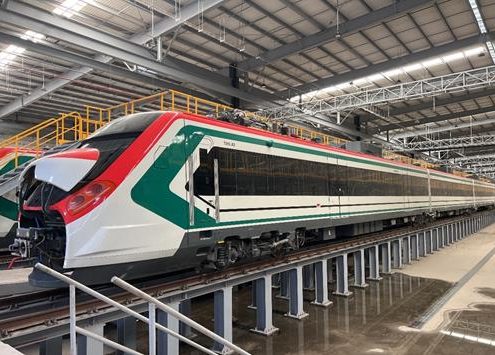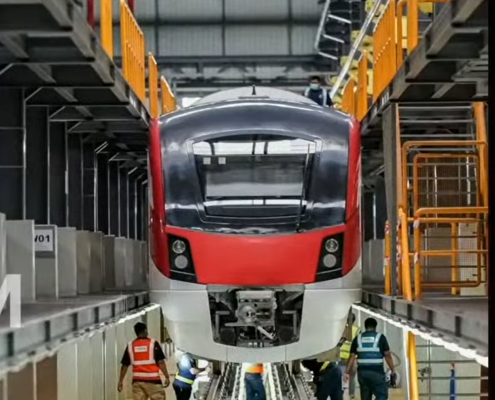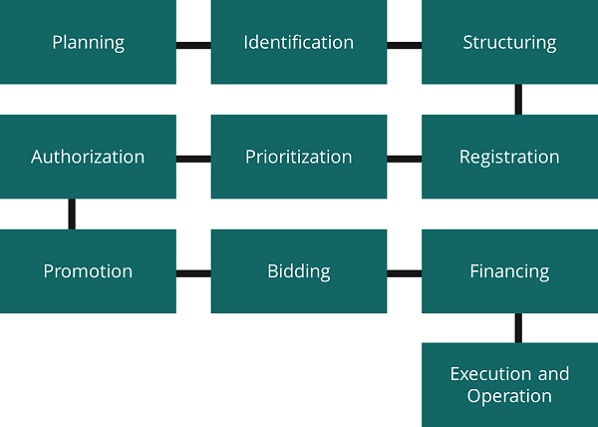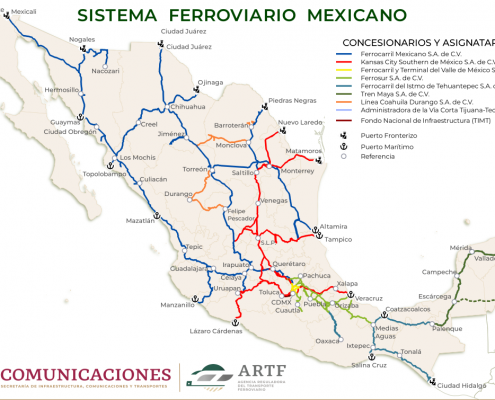Last Review: April, 2025
Banobras offers interested parties information on the sector in Mexico with data from various sources in order to provide knowledge on the subject and useful elements for decision-making at the sectoral level. The content presented does not reflect the position of Banobras.
The Government of Mexico announces that this year the construction of the AIFA – Pachuca, Mexico – Querétaro, Querétaro – Irapuato, and Saltillo – Nuevo Laredo sections will begin. Go to website
Current status
According to ARTF, rail connectivity at ports is a key factor for the development of intermodal corridors in the country. Currently, 69% of the ports managed by federal Administrations of the National Port System (ASIPONAS) have rail connection. However, there are challenges to improve the integration of these corridors, especially through last mile connection projects, shortening and rehabilitation of railroad tracks.[1]
The Mexican Railway System has an extension of 26,914 km, divided into 20,825 km of trunk and branch lines, 4,533 km of secondary tracks, and 1,555 km of private tracks connected to the trunk lines. Of this total, 17,642 km have been concessioned to the private sector for operation.[2].
In terms of international connectivity, the Mexican rail system is linked to the United States network and to the southern border with Guatemala and Belize, with the aim of facilitating integration with global markets and strengthening Mexico’s competitiveness as a key logistical node in the region.

Source: Mexico-Toluca Interurban Train “El Insurgente”, Ministry of Infrastructure, Communications and Transport (SICT).
Freight Transportation
The Public Rail Freight Transportation Service reached an all-time record by mobilizing 131.48 million tons, representing an increase of 2.35% compared to 2022.
The main products transported were industrial (48.54%), agricultural (26.73%) and oil and its derivatives (12.18%). Likewise, 92, 132 billion ton-kilometers were recorded in 2023,an increase of 5.81% compared to the previous year.
For more information, the “General Map of the Freight Rail Transport System” is available. This map provides, in addition to the identification of concessionaires and assignees, information on the nomenclature of the railway lines, details of the Valley of Mexico, and the Monterrey metropolitan area. It also shows the tracks that are currently not in operation (remaining tracks) but still have a right-of-way granted by the federal government.
Passenger Transportation
The Public Rail Passenger Transportation Service mobilized 45.84 million passengers and a total of 1,014.88 million passenger-kilometers. Compared to 2022, there was an increase of 11.78% in the number of passengers transported and 23.39% in passenger-kilometers.
For more information, the “General Map of the Passenger Rail Transport System” is available. Currently, there are five routes operating in the states of Baja California, Chihuahua-Sinaloa, Mexico City-State of Mexico, Jalisco, and Puebla, with one more under construction in the southeastern region of Mexico.
Railway safety
During 2023, 1,254 incidents related to operational safety were reported, representing a reduction of 2.94%, while in terms of public safety, 13,916 incidents of theft and vandalism were recorded, reflecting a decrease of 13.04% compared to the previous year.
Railway equipment
The operable car fleet, consisting of 1,209 locomotives and 30,369 operable cars, increased by 0.92% and 0.71%, respectively, compared to 2022. The 72.11% of the hauling fleet consisted of gondolas (31.93%), hoppers (23.92%) and boxcars (16.27%). On the other hand, active personnel in 2023 grew by 4.28%, from 15,087 to 15,733 employees.
Energy consumption
Suburban energy consumption reached 34.26 million kilowatt-hours (KWh), representing an increase of 1.15% compared to the previous year. In freight transportation, diesel consumption reached 688.84 million liters, experiencing a 6.15% growth compared to 2022.
Railway economic information
Concessionaires and assignees generated, in 2023, total revenues from rail freight transportation services of $81,979.8 million pesos and total operating costs reached $47,612.5 million pesos.
Foreign Trade
In 2023, a total volume of 22.9 million net tons of exports was recorded, reflecting a decrease of 6.7% with respect to the previous year. On the other hand, imports reached 71.1 million net tons, showing an increase of 4.7%. At the national level, merchandise trade totaled 37.5 million net tons, with a growth of 4.0%. Of the total foreign trade cargo, 73.26% was transported across borders, while the remaining 26.74% was transported through ports.
Concessionaires of the Mexican Railway System
Within the concessionaires of the Mexican Railway System, the following are included:
- Kansas City Southern de México, S.A. de C.V.
- Ferrocarril y Terminal del Valle de México, S.A. de C.V.
- Ferrocarril Mexicano, S.A. de C.V. (Vía Troncal Pacifico Norte).
- Ferrocarril Mexicano, S.A. de C.V. (Ojinaga-Topolobampo).
- Línea Coahuila-Durango, S.A. de C.V.
- Ferrosur, S.A. de C.V. (Vía General de Comunicación Ferroviaria del Sureste).
- Ferrocarril Mexicano, S.A. de C.V. (Vía Corta Nacozari).
- Ferrocarriles Suburbanos, S.A.P.I. de C.V.
- Ferrosur, S.A. de C.V. (Vías Cortas Oaxaca y Sur).
The assignors are listed below:
- Vía general de comunicación ferroviaria Tijuana-Tecate (Admicarga).
- Ferrocarril del Istmo de Tehuantepec (FIT).
Currently, FIT operates 3 commercial transport lines in Mexico, with almost 1,000 km of railway track:
- Line “Z” Medias Aguas – Salina Cruz: The states of Oaxaca and Veracruz are connected through 212 km of railway. It links the ports of these states, playing a key role in the development of the Interoceanic Corridor of the Isthmus of Tehuantepec.
- Line “FA” Chapo-Palenque: It travels through the states of Veracruz, Tabasco, and Chiapas, with a total of 310 km. This transport system provides the movement of cargo via the Gulf of Mexico from Coatzacoalcos to the Yucatán Peninsula, covering the southeast, with a connection to the Maya Train in Palenque and the connection to the Dos Bocas Refinery.
- Line “K” Ixtepec – Ciudad Hidalgo: This line runs through the states of Oaxaca and Chiapas, covering 472 km of railway. There are plans for it to connect with Guatemala through the Guatemala Railway and the development program for the Southern Border.
The SICT, through the Railway Transportation Regulatory Agency, has a page called “Sistema Ferroviario Mexicano – Concesionarios y Asignatarios” (Mexican Railway System – Concessionaires and Assignees), which offers an interactive map of the situation of railroads in Mexico. This site contains several sections dedicated to the management and monitoring of rail transportation:
[1] Rail Transport Regulatory Agency (ARTF), Yearbook 2023.
[2] Ministry of Communications and Transportation (SCT), Yearbook 2022.
Institutional Arrangement
In terms of infrastructure, Mexico has a defined strategy that offers investors medium and long-term visibility regarding the development of projects, through a series of plans and programs of national and sectorial scope. To access the information, please consult the following documents:
Communications and Transportation Sector Program 2020-2024
Organizational Structure
Description of the hierarchy and roles of the different entities and actors involved in the sector, including how the different institutions and agencies coordinate and collaborate.
The development of railway infrastructure in Mexico is led by the Ministry of Infrastructure, Communications, and Transportation (SICT), which designs short-, medium-, and long-term sectoral programs to enhance the competitiveness of the railway system.
The SICT is responsible for identifying and structuring railway projects, either through public investment or via Unsolicited Proposals (PNS) under a mixed investment scheme, aligning these initiatives with national and sectoral plans. Through its General Directorate of Railway and Multimodal Transport, the SICT conducts studies and submits registration requests to the Investment Unit of the Ministry of Finance and Public Credit (SHCP) for projects requiring public funding.
The execution of these projects is the responsibility of operators and developers awarded contracts through tenders managed via CompraNet. Once awarded, the SICT oversees proper implementation and operation to ensure compliance with contractual terms.
Undersecretary of Transportation
Area of the SICT in charge of guaranteeing modern and sufficient transportation infrastructure that promotes the provision of quality and competitive services, thus contributing to the sustainable development of the country.
General Directorate of Railway and Multimodal Development
Formerly the General Directorate of Railroad and Multimodal Transportation, it´s the unit of the Undersecretary of Transportation in charge of planning and formulating policies and programs, regulating the railroad system, as well as granting concessions and permits, verifying compliance and determining modifications and terminations.
Promotes a safe, efficient and competitive railroad system by regulating, monitoring and verifying the construction, operation, exploitation, conservation and maintenance of the railroad infrastructure, the public railroad transportation service and its auxiliary services.
The Mexican railroad system consists of 26,914 km of which 17,642 km are concessioned to the private sector for operation.
CIIT is a decentralized public agency with its own assets and legal personality, which is part of the Ministry of the Navy. CIIT’s objective is to develop the Isthmus of Tehuantepec region in an integral, sustainable, sustainable and inclusive manner.
Its purpose is to implement a logistics platform that integrates the port administration services provided by the competent entities in the Ports of Coatzacoalcos, Veracruz de Ignacio de la Llave and Salina Cruz, Oaxaca, and their interconnection through railroad transportation, as well as any other action that contributes to the development of the Isthmus of Tehuantepec region, with an integral, sustainable, sustainable and inclusive vision, promoting economic, productive and cultural growth.
Legal system
For projects to which the PPP Law does not apply, the sector is governed by specific regulations, which can be found at the following link:
SICT
Public Works and Related Services Law

Mexico – Queretaro Train
Investment cycle
The following section provides an overview of the project development process from initial planning to final execution.

Planning
SCT establishes medium and long term sectorial programs for airport infrastructure development, based on the objectives and strategies defined by the National Development Plan and the National Infrastructure Program. The principal objectives are to: a) develop bypasses and relocate railway tracks; b) build shoulders; c) carry on works for logistics nodes; d) rehabilitate and maintain railways and bridges; and, e) implement a comprehensive program of railway safety.
Identification
SCT identifies railway projects to be developed, in accordance with planning documents. Unsolicited proposals of PPP projects must be aligned to national and sectorial plans.
Structuring
The General Direction of Railway and Multimodal Transport prepares, by itself or by means of third parties, the necessary pre-investment studies and analysis, required for the development of railway and multimodal projects.
Registration
For those projects that require federal funds, SCT presents a registration application to the Investment Unit of the Ministry of Finance (whether funded with fiscal budget or by the National Infrastructure Fund or FONADIN).
Prioritization
The CIGFD will evaluate the projects that require the allocation of federal funds, and will decide its inclusion in the draft of the annual expenditure budget. Additionally, this commission will determine the prioritization of the projects based on a) socioeconomic profitability; b) its impact in extreme poverty reduction; c) regional development, and d) concurrence with other programs and investment projects.
Authorization
- Projects that require federal funds are authorized by by the House of Representatives.
- Projects with funding from FONADIN are authorized by the Fund.
- The IU will issue an opinion of economic viability for those projects that do not require public resources.
Promotion
The Railway and Multimodal Transportation General Direction is responsible for the promotion of the projects
Bidding
The bidding process is responsibility of the Railway and Multimodal Transportation General Direction, and the process must be registered in CompraNet.
Financing
Different sources of funds are available for the projects, depending on their particular characteristics and their financial structure, including federal funds or PEF, and funds form the FONADIN, BANOBRAS, commercial banks, institutional and private developers, and from institutional investors.
Execution and Operation
Carried out by the awarded operators or developers, under the surveillance of the SCT, according to contract terms.
Projects
The following section provides information on the different types of projects:
- New projects (pre-investment, bidding and execution) and in operation within the Mexico Projects Hub platform, which at some stage of the project were considered investment opportunities and do not necessarily have Banobras / Fonadin participation.
- Strategic Projects of the Federal Public Administration.
New Projects
| Project | Sector | Subsector | Stage | Sustainability | With Ally Networks |
| México-Toluca Interurban Train | Transport | Railways | Execution | No | No |
| 0961 Queretaro – Irapuato Train | Transport | Railways | Preinvestment | No | No |
| 0960 Saltillo – Nuevo Laredo Train | Transport | Railways | Preinvestment | No | No |
| 0954 Mexico-Queretaro Train | Transport | Railways | Preinvestment | No | No |
| 0953 Mexico-Pachuca Train | Transport | Railways | Execution | No | No |
Projects in Operation
| Project | Sector | Subsector | Stage | Sustainability | With Ally Networks |
| Mayan Train | Transport | Railways | Operation | No | No |
| 0281 Istmo de Tehuantepec Short Railway | Transport | Railways | Operation | Yes | No |
| 0280 Cuautitlan-Buenavista Suburban Train Route | Transport | Railways | Operation | Yes | No |
| 0278 Coahuila-Durango Railroad | Transport | Railways | Operation | Yes | No |
| 0277 Valley of Mexico Railroad | Transport | Railways | Operation | Yes | No |
| 0276 Corta Sur Railroad | Transport | Railways | Operation | Yes | No |
| 0275 Nacozari Railroad | Transport | Railways | Operation | Yes | No |
| 0274 Pacific-North Railroad | Transport | Railways | Operation | Yes | No |
| 0273 Ojinaga-Topolobampo Railroad | Transport | Railways | Operation | Yes | No |
| 0272 Southeastern Railroad | Transport | Railways | Operation | Yes | No |
| 0271 Northeastern Railroad | Transport | Railways | Operation | Yes | No |
Banobras / Fonadin
Project Finance: In order to support the financing of infrastructure projects and public services, the Project Finance Unit structures financing supported by the granting of loans and guarantees to those projects developed as Public-Private Partnerships and which have their own source of payment from the exploitation of the concession or public contract or from the collection of the service in question. The Public-Private Partnership schemes may be Federal and/or Local, in their different modalities, such as: Concessions, Service Provision Projects (PPS) or Financed Public Works Contracts, among others.

Financing for States and Municipalities and Decentralized Public Organizations: The products and services are designed to meet the infrastructure needs of states, municipalities and their decentralized public organizations, in order to improve the quality of life of the population and increase competitiveness.
Infrastructure is a pillar of development, which is why Banobras has innovative products and services focused on contributing to regional development through the promotion of financial mechanisms to:
Boost investment in infrastructure and public services.
Promote the financial and institutional strengthening of states, municipalities and decentralized public agencies.
To this end, Banobras has the following financing schemes:
Products:
Project Development: Banobras offers services aimed at assisting public sector agencies and entities in the development of infrastructure projects.
Financial structuring of the project:
- Elaborate and/or update studies required by the Public-Private Partnerships Law.
- Support in the review of the bidding conditions and contract model.
- Assist in obtaining financing for the project.
- Assist in the registration process of the project in the portfolio of the Investment Unit of the Ministry of Finance and Public Credit (SHCP).
- Assist in dealing with any observations made by the SHCP Investment Unit.
- Support in the financial closing of the project.
The purpose of the Fondo Nacional de Infraestructura (Fonadin) is to serve as the Federal Public Administration’s coordination vehicle for infrastructure investment. It has one of the largest road concession networks in the world and manages the granting of financial support for infrastructure development, mainly in the areas of communications, transportation, water, environment, energy, tourism, urban and strategic and priority areas, supporting the planning, promotion, construction, conservation, operation and transfer of infrastructure projects with social impact and economic or financial profitability.

It has a wide range of products designed to strengthen the financial structure of the infrastructure projects that the country requires, from the conception to the completion of the projects, providing the following financial instruments that make the projects more attractive for financing with private resources:
Recoverable Support
- Simple Credits
- Subordinated Credits
- Guarantees
- Investments in Venture Capital Funds
- Infrastructure Trust Investments
- Financing of Studies and Advisory Services
Non Recoverable Support
- Contributions for Studies and Consultancy
- Contributions for Projects
- Project Grants
Contact: fonadin.transporte@banobras.gob.mx
Sustainability
Banobras makes available to interested parties, analysis sheets for the detection of sustainability practices in infrastructure projects, in accordance with the methodological framework “Attributes and Framework for Sustainable Infrastructure” of the Inter-American Development Bank (IDB). Its objective is to highlight sustainable practices, encourage their adoption in future projects and provide relevant information for investors in their economic, environmental, social and institutional dimensions.
To consult the projects that already have a sustainability record, select the “SEARCH CRITERIA>” option in the PROJECTS section, and then select “With Sustainability Analysis”; the projects that have a record will be displayed below.
In addition, Banobras offers an analysis tool that presents the potential relationship of the different infrastructure projects of the Mexico Projects platform with the 17 Sustainable Development Goals (SDGs) of the 2030 Agenda and their targets. This comparative analysis facilitates the use of data according to different criteria, such as the potential impact of projects and sectors against national and global development goals.
The comparison is only made between projects in the same subsector. To select and consult here.
The alignment of a project with the SDGs provides information on the degree of focus on sustainability; it provides a comparison between projects in the same sector and sub-sector and facilitates investment decisions, showing the highest and lowest alignment of projects to the SDGs. Comparative analysis facilitates the use of data according to different criteria, such as the potential impact of projects and sectors against national and global development goals.
In the case of the sector, 11 projects are identified in the platform that have sustainability practices detection sheets, which allows to know, among other things, the projects with more and better alignments to the SDGs. For more information, access the Sustainable Development Goals application:

Greater alignment of the sector:
- SDG 9: Industry, innovation and infrastructure
- SDG 8: Decent work and economic growth
- SDG 7: Affordable and clean energy
- SDG 16: Peace, justice and strong institutions
Reduced alignment of the sector:
- SDG 2: Zero Hunger
- SDG 4: Quality Education
- SDG 14: Underwater Life
Ally Networks
Banobras, through its Ally Networks application, provides information on companies participating in competitive public procurement processes for infrastructure projects in Mexico, based on official sources such as ComprasMX. It includes details on investment amounts, number of participations in bids, projects awarded, consortiums, and business associations, which allows the user to identify potential actors for the establishment of investments in the country.
To consult the projects that have information on the participating companies, select the option “SEARCH CRITERIA>” in the PROJECTS section, and then select “With applicant companies” at the end of the criteria.
Reference documents:
This section offers documents, reports and reports with technical, statistical and regulatory information on the sector:
Official statements:
2024
- DOF: The agreement by which powers are delegated to the head of the decentralized body of the Secretariat of Infrastructure, Communications, and Transport, known as the Railway Transport Regulatory Agency.
- DOF: DECREE amending the fourth paragraph and adding a fifth paragraph to Article 28 of the Political Constitution of the United Mexican States, regarding railroads and railroad transportation.
Additional information:
2024
- ARTF: Statistical Yearbook of the Mexican Railway System
- ARTF: (Government Management Report of the Railway Transport Regulatory Agency 2018-2024)
- ARTF: Annual Report 2024
- ARTF: National System of Railway Indicators 2024
- Center for Public Finance Studies (CEFP): National Passenger Rail System – Status 2024
- SICT: Historical Semblance of the General Directorate of Railway and Multimodal Development
- SICT: “SICT and European Union sign letter of intent for an efficient, sustainable and inclusive Mexican Railway System”
- World Bank: Manual for the Development of Urban Railways, 2021




